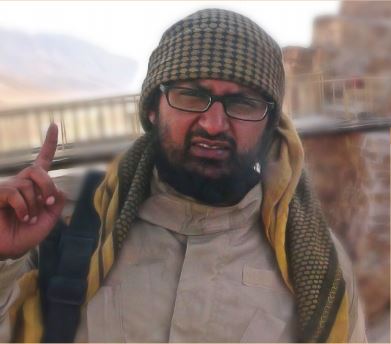
Islamic State’s Sri Lankan Outreach
Publication: Terrorism Monitor Volume: 13 Issue: 23
By:

In recent months, there has been growing evidence of actual and attempted outreach by the Islamic State into Sri Lanka, presently struggling to recover from a three-decade long conflict between its Sinhalese and Tamil ethnic groups. One of the most significant developments was the news of two Sri Lankan nationals fighting with the Islamic State in Syria and Iraq. One such report, in July 2015, indicated that a Sri Lankan national in his mid-30s, identified as Mohamed Muhsin Sharfaz Nilam (a.k.a. “Abu Shurayh al-Silani”), was killed while fighting in Raqqa, Syria, during a U.S.-led coalition airstrike. Sri Lanka’s prime minister subsequently ordered investigations into possible Islamic State influence in the country to fathom the levels of radicalization among its minority Muslim populace.
The news of Nilam’s death was released by another Sri Lankan, Thauqeer Ahmed Thajudeen (a.k.a. “Abu Dhujaana Silani”), who is believed to be still fighting with the Islamic State in Iraq and Syria (LankaNewsPaper.com, July 26). Six months after Nilam’s death, the November 2015 issue of the Islamic State’s online magazine Dabiq paid tribute to its slain Sri Lankan fighter:
A cursory look at Nilam’s life gives us some clues on his Islamic education background and possible radical orientations. A resident of Warallagama of Kandy district, Mohamed Muhsin Nilam received an education in Shari’a law at Pakistan’s International Islamic University before returning to Sri Lanka. He afterwards became a visiting Urdu teacher in the capital’s Colombo University before 2012, and later became principal of a school in Galewala, Kandy (Sunday Times [Colombo], July 26).
Besides Urdu and Islamic law, Nilam was known locally as a martial arts trainer as he gave karate lessons at various schools as an instructor in Maharagama, Kotahena and Kandy. However, he left the Galewala school in 2014, reportedly informing the school administration that he would travel to Mecca with his family for pilgrimage in January 2015 (Sunday Times [Colombo], July 26). Per available reports, Nilam and his entire family of six children, then pregnant wife and his parents obtained tourist visas in December 2014 to visit Turkey. Information given in Dabiq about Nilam claimed that he was in fact leading a party of 16 Sri Lankan nationals, including his family members, to perform hijrah (migration) not to Mecca but to the Islamic State’s so-called caliphate in Iraq and Syria. [2]
Insights into some of Nilam’s motivations are given by his posts on Facebook. For instance, in one post, dated July 3, 2015, he wrote: “America, Iran, Bashar [al-Assad, president of Syria], Arab Countries, 70 other countries are fighting [the Islamic State]. The only country who doesn’t fight is Sri Lanka. So logically [the Islamic State] is a product of Sri Lanka” (Facebook, July 3). On the same day he posted an image of the Islamic State’s leader, Abu Bakr al-Baghdadi, with text that said “We will kill every man, woman, child, Shi’a, Sunni, Zoroastrians, Kurds, Christians” (Facebook, July 3).
In another of his many Facebook postings, Nilam went on to justify al-Baghdadi’s position as the caliph and attempted to validate the legitimacy of the Islamic State’s caliphate. He seemed to be prepared for any eventuality in his life with the jihadist organization. For instance, he wrote a prayer that: “May Allah guide us all, make us steadfast in the truth until death, make our life and death pleased to Him, and grant us death of a Shahid [martyr]” (Facebook, June 28). His more recent Facebook posts prior to his death dealt with discussions of the caliphate, Shari’a and eulogizing the Islamic State’s martyrs. According to Dabiq, Nilam was engaged in “dawah” (recruitment) activities, as well as taking part in battles for the T3 gas fields and Jazal, located in “Wilayat Homs” in Syria. [3]
Nilam and Thajudeen’s cases have spurred debate in Sri Lanka about the possible inroads of the Islamic State into the country and whether its local supporters are now actively scouting potential foot soldiers. The security establishment is at present apprehensive about two things: the existence of Islamic State-linked jihadist networks in the country and that several other Sri Lankan nationals may also be fighting for the jihadist group in Iraq and Syria. For instance, like Nilam and Thajudeen, another Lankan national from Colombo who has pledged allegiance to the Islamic State and is very active on Facebook is Abu Abdulla Silani, who has mentioned in his online profile that he, too, is a solider of the Islamic State and lives in the group’s self-declared capital, Raqqa, in Syria, according to his now-deleted Facebook page.
Moreover social networking sites have many Sri Lankan nationals and groups who claim to be affiliated with jihadist groups in Syria and Iraq, and are mostly linked with the Islamic State. For instance, a Facebook group named “Seylan Muslims in Shaam” (Sri Lankan Muslims in the Levant) urged Sri Lankan people, irrespective of Tamils or native Singhalese, to join the Jihad bandwagon. For instance, in a message posted on August 16, the group said:
The message even urged the Muslims of Sri Lanka:
It exhorted further: “O Muslims of Sailaan, after 90 years your Khilafah (caliphate) is back, and despite 70 nations pouncing on it, the Khilafah is remaining and expanding.” [6]
While the government of Sri Lanka investigates the growing stature of the Islamic State, several Muslim clerics’ organizations, like All Ceylon Jamiyyathul Ulama (ACJU), have issued a joint statement denouncing the jihadists’ violent agenda and naming it as a deviant organization. The statement also condemned all or any Lankan individuals associated with the the Islamic State. The ACJU also urged the Colombo administration to take action against any individual involved in any form of extremism (Colombo Telegraph, July 25).
The government’s and ACJU’s stands against the Islamic State’s outreach activities notwithstanding, grassroots radicalization of some Muslim youths in Sri Lanka is potentially directly connected with many violent skirmishes between Sri Lankan Muslims and vigilante groups associated with the majority Buddhist population in recent years.
Not only are anti-Buddhist sentiments high among a section of Muslim populations in Sri Lanka, but alarmingly, the minority population is more vulnerable to increasing attempts by Salafist sectarian groups, such as Sri Lanka Thawheed Jamaat (SLTJ), which not only promotes sectarian discord within Islam, but also attempts to preach a rabid strain of Islam that largely despises the practices and existence of other Islamic sects like Shi’as and Ahmadiyas (New Indian Express, November 8). [7]
These many fast shifting situations in Sri Lanka would possibly provide an opportunity for transnational jihadist groups like the Islamic State, which has been attempting to spread its influence beyond its base in Iraq and Syria. And most certainly, the group’s propaganda machinery would attempt now to portray native fighters like Nilam in an Islamic and heroic light to create an atmosphere of sympathy and support for the caliphate within the Sri Lanka’s Muslim minority population.
Animesh Roul is the Executive Director of Research at the New Delhi-based Society for the Study of Peace and Conflict (SSPC).
Notes
1. The November 2015 issue of Dabiq can be found at https://azelin.files.wordpress.com/2015/11/the-islamic-state-e2809cdc481biq-magazine-12e280b3.pdf.
2. Ibid.
3. Ibid.
4. The group’s protected Facebook page can be found at https://www.facebook.com/seylanmuslimsinshaam/posts/1663851737179801:0.
5. Ibid.
6. Ibid.
7. For instance, Thawheed Jamaath’s attempt to get Saudi and foreign funding to protect Sri Lankan Muslims and views against Lankan Buddhists and government, See,“Thawheed Jamaat’s Call To Protect SL Muslims Irks Security Establishment” Colombo Telegraph, July 23, 2014, https://www.colombotelegraph.com/index.php/thawheed-jamaats-call-to-protect-sl-muslims-irks-security-establishment/.





